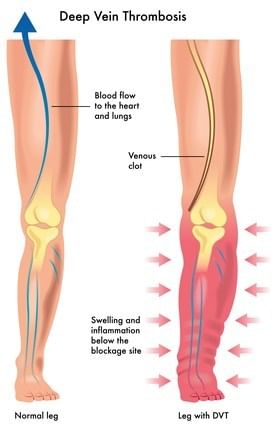Deep Vein Thrombosis - Causes, Symptoms & Treatment!
Deep vein thrombosis (DVT) is a condition of the blocked deep vein (especially of legs) with blot clot called thrombus. When any of the deep veins are blocked, It results in the swelling, redness, pain and warmth feeling of on the affected site. Sometimes the clot travels through the blood to lungs and causes a pulmonary embolism.
SIGNS & SYMPTOMS-
* Swelling
* Redness
* Pain
COMPLICATIONS-
* Pulmonary embolism
* Postphlebitic syndrome (it is characterized by pain, swelling, brownish or reddish skin discoloration and skin ulcer on the leg)
RISK FACTORS-
Many factors can increase your risk of developing deep vein thrombosis (DVT).
* Inheriting a blood-clotting disorder. Some people inherit a disorder that makes their blood clot more easily. This condition on its own might not cause blood clots unless combined with one or more other risk factors.
* Injury to a vein
* Abdominal and pelvic Surgery
* Pregnancy. Pregnancy increases the pressure in the veins in your pelvis and legs
* Prolonged bed rest
* Being overweight or obese
* Birth control pills (oral contraceptives) or hormone replacement therapy
* Smoking
* Cancer
* Age. Being older than 60
* Sitting for long periods of time
PREVENTION-
* Calf muscle stimulation during surgery
* Active leg exercises
* Graduated support stocking
* Treatment for DVT
* If you have had surgery or have been on bed rest for other reasons, try to get moving as soon as possible
* If you're sitting for a while, don't cross your legs which can hamper blood flow
* If you're traveling a long distance by car walk around
* If you're on a plane, stand walk occasionally
* If you can't do that exercise your lower legs
* Lose weight
* Quitting smoking
HOSPITAL MANAGEMENT-
* Supportive care
- maintaining hypotention
* Anticoagulation therapy
- heparin
- warfarin
* Thrombolytic therapy
- streptokinase or tPA to hasten the lysis of pulmonary embolus or emboli
* Inferior vena cava interruption (if thrombolytic and anticoagulant therapies are contraindicated or if the patient continues to have recurrent pulmonary embolism despite these therapies, vena caval interruption is indicated by the transvenous placement of Greenfield filter in the inferior vena cava just below the renal veins)
* Pain relief
* Anticoagulant medications
HOMEOPATHIC TREATMENT-
* THROMBOSIS, lower limbs - Apis mel
* Edema of Foot - Apis., Ars., aur-m., aur., Chel., dig., Kali-c., kali-i., lach., Lyc
* Red swelling of foot - Ars., bry., carb-v., Kali-c
* Red blue swelling of the foot - Ars alb
* Swelling foot painful - Apis., ars., aur., led., merc., sulph





+1.svg)
